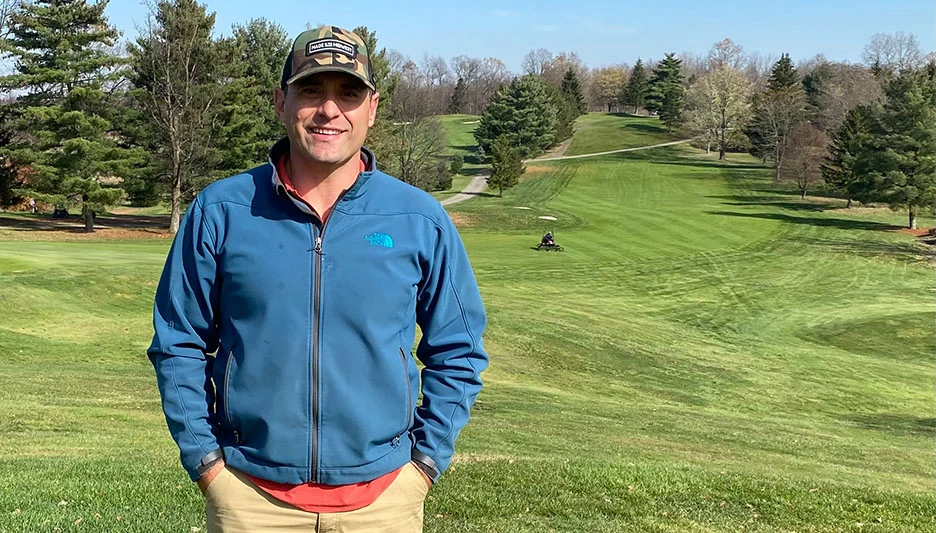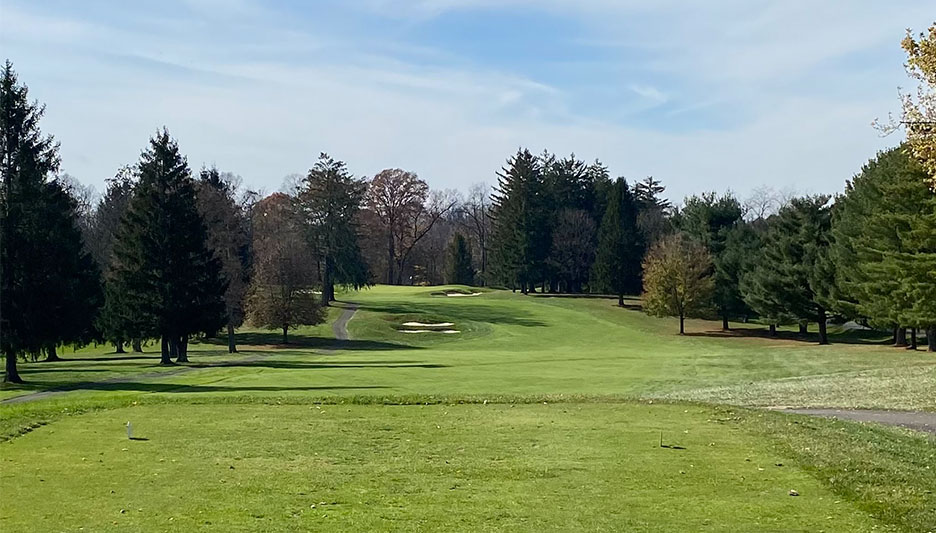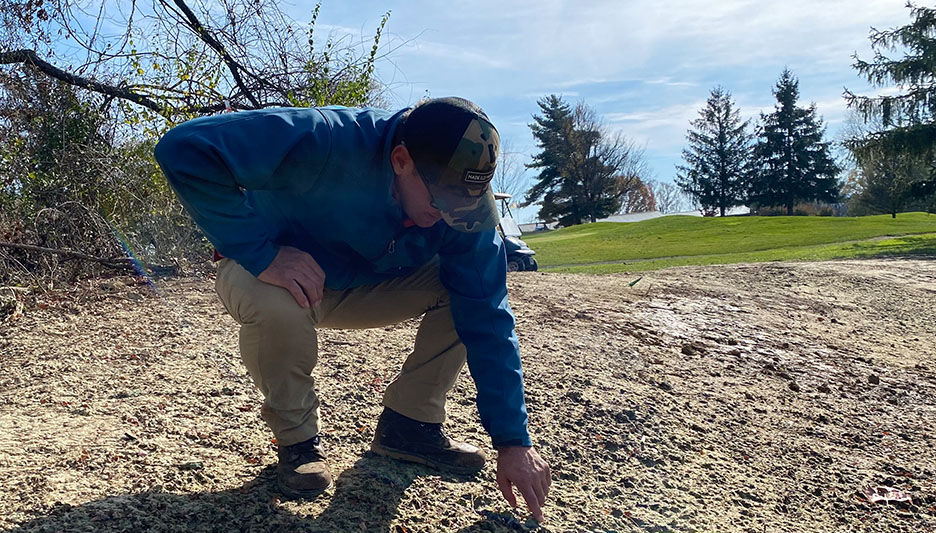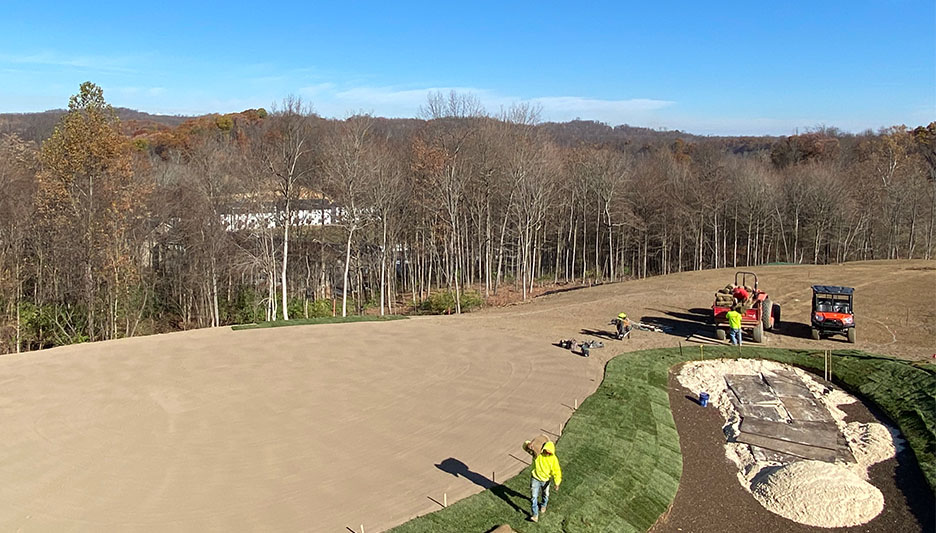
Guy Cipriano (4)
Like hundreds of practice facilities in America these days, the range and short-game area at The Pines Country Club in Morgantown, West Virginia, is being renovated for the first time.
Teeing space will expand to 10,000 square feet, with synthetic mats neatly aligned on the exterior. Members will loft shots to five target greens inside the eight-acre range. A formal spot to hone chips, pitches and bunker blasts should lower handicaps.
On the first Monday of November, superintendent Mike Bogroff surveys the activity around him. A crew from Aspen, a golf construction firm based on the southern end of the state, delicately places strips of turf type tall fescue sod around the practice bunker as a brave worker standing atop a slowly moving truck hydroseeds the periphery of the practice green and range tee. Foursomes, threesomes and twosomes fill the course. The clock changed the previous day, yet temperatures hit the 60s. “We’re not slowing down at all around here,” Bogroff says.
Bogroff makes time to appreciate his surroundings, even amid the hustle. He gazes beyond the golfers, workers and the truck, and points to Coopers Rock State Forest, a popular rock climbing and hiking destination 15 miles to the west. Once the ashes and maples deposit leaves, he receives an unobstructed view of the popular park from his office window.
“I’m a water guy,” Bogroff says, “but the mountains have grown on me. It’s beautiful.”
A northern Michigan native, where the blue and green hues of Lake Michigan mesmerize and hundreds of lakes dot the inland landscape, Borgoff moved to Morgantown in 2006 to accept his first head superintendent job at The Pines, an Edmund Ault design opened in 1970. Bogroff and his wife are raising three children in Mountaineer Country, a moniker attached to the region because of nearby West Virginia University. Bogroff has learned to root for the Mountaineers on fall Saturdays, although he considers Michigan State, where he earned a two-year turfgrass management certificate, his favorite college team. “The conversations in the lunchroom … every day it’s football,” he says.

Bogroff’s 17-year run at The Pines illustrates how careers lead to talented individuals adapting and flourishing in unexpected places. And the seventh and eighth greens illustrate a work conundrum Bogroff never encountered while learning the industry in the Upper Midwest by helping his uncle Ralph Trim build a par-3 course and working as an assistant under the legendary Monroe Miller at Blackhawk (Wisconsin) Country Club and respected northern Michigan turf leader Steve Hammon at Traverse City (Michigan) Country Club.
The par 4s sliver through the front boundary of the property and feature north-facing greens surrounded by bunkers. Observing the greens proved to Bogroff that he had ditched a comfortable Upper Midwest growing environment for the volatility of the Transition Zone. The two greens, according to Bogroff, possess the highest Poa annua populations on the course. They are also surrounded by Bermudagrass.
“That’s the epitome of the northern Transition Zone,” he says. “What you see in the middle of the summer is that when the Poa is weaker on the greens, the Bermudagrass is thriving on the surrounds. That’s when you know you’re in a battle.”
Bogroff admits his first two summers in Morgantown were “tough,” as he endured prolonged stretches of heat and humidity, two variables he rarely encountered in Michigan and Wisconsin. Around that time, the annual bluegrass weevil started migrating into northern West Virginia. He also made his first widespread crabgrass control herbicide application.
“That was a thing we never did up north,” Bogroff says. “You might have the front of a fairway and some parts of the rough that get crabgrass every other year, so you’ll spray for that. But here it’s a wall-to-wall spray or it will just be a field of crabgrass.”
 The unfamiliar started feeling familiar in the middle of Bogroff’s third summer. The Pines invested in a new irrigation system, which replaced the original system designed by Ault and his construction team. The new system meant he no longer needed to manually irrigate turf at night.
The unfamiliar started feeling familiar in the middle of Bogroff’s third summer. The Pines invested in a new irrigation system, which replaced the original system designed by Ault and his construction team. The new system meant he no longer needed to manually irrigate turf at night.

Bogroff has never employed an assistant. But developing a loyal team of full-timers, retirees and college students helps ease the angst of Transition Zone maintenance. He expanded his industry network, and he’s a staple at state, regional and national conferences. His industry involvement mirrors the philosophies of Miller and Hammon, a pair always seeking ways to learn and advance the industry.
Working at The Pines, a club with just four superintendents in its 43-year history, offers job security and the course has evolved nicely over the past 17 years. While standing on the practice green on the early November day, Bogroff scans the second and 18th greens. When he started at The Pines, members couldn’t see any golf below because of a cluster of trees. They now see both greens — along with the 14th and 15th holes and a distant ridgeline — from the practice green.
Tees have been added over the years; bentgrass has become the dominant species on tees and fairways. Bogroff has refined his agronomic programs in response to longer golf seasons. Fall aerification used to begin the day following Labor Day. This year, Bogroff’s team waited until Oct. 19 to begin aerifying.
Like thousands of clubs in America, The Pines is flourishing in the post-COVID golf market. The club supported more than 23,000 rounds in 2023; play hovered around 15,000 annual rounds before the pandemic. Facility improvements are accompanying revenue spikes. The Pines unveiled a renovated pool last year. The renovated practice facility opens this year. Additional enhancements are being planned.

Away from the course, Bogroff and his wife, whose children are 18, 11 and 4, appreciate living in a place centrally located to the outdoor activities they relish. The shores, lakes and sand dunes of northern Michigan and the ski slopes of Vermont are within a day’s drive. Outdoorsy spots such as Coopers Rock, Canaan Valley, West Virginia, and Deep Creek, Maryland, lurk nearby.
Bogroff didn’t envision still being in Morgantown in 2023 when he arrived at The Pines as a 27-year-old rookie superintendent. The brightest rookies transform into dependable veterans. They evolve and make everything around them better.
“Being here for 17 years … I think that’s rare,” Bogroff says. “I think around Year 7 or Year 8, guys are looking to make the next jump. It’s a good club. If they treat you well, you have no reason to look around.”
Guy Cipriano is Golf Course Industry’s editor-in-chief.
Latest from Golf Course Industry
- From the publisher’s pen: Technology diffusion and turf
- Applications open for 2025 Syngenta Business Institute
- Smart Greens Episode 1: Welcome to the digital agronomy era
- PBI-Gordon promotes Jeff Marvin
- USGA investing $1 million into Western Pennsylvania public golf
- KemperSports taps new strategy EVP
- Audubon International marks Earth Day in growth mode
- Editor’s notebook: Do your part





